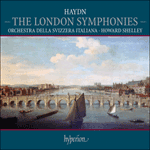
Welcome to Hyperion Records, an independent British classical label devoted to presenting high-quality recordings of music of all styles and from all periods from the twelfth century to the twenty-first.
Hyperion offers both CDs, and downloads in a number of formats. The site is also available in several languages.
Please use the dropdown buttons to set your preferred options, or use the checkbox to accept the defaults.

| Orchestra della Svizzera Italiana, Howard Shelley (conductor)» More |
‘Nothing can be more original than the subject of the first movement’, enthused the Morning Chronicle after No 101’s premiere; ‘and having found a happy subject, no man knows like HAYDN how to produce incessant variety without once departing from it.’ As usual in the ‘London’ symphonies, the motivic seeds are sown in the slow introduction, which prefigures the 6/8 Presto’s ‘happy’ (and teasingly irregular) subject in D minor. Again, though, it is the second subject—a playful, sinuous tune, closely akin to the first—that controls the plot, both in the development and in another of Haydn’s gloriously unpredictable, expanding recapitulations.
Such is the symphonic weight and grandeur of the minuet, the longest in a Haydn symphony, that it comes as a surprise to learn that it was adapted from a minuet he had composed for mechanical organ. The trio’s pointedly naïve flute solo is accompanied by a notorious ‘wrong harmony’ joke which the strings then rectify on the repeat. Nineteenth-century editors with a musical humour bypass thought the joke must be a misprint and duly ‘corrected’ it. Opening with a mellow, songful theme, the finale is a sonata rondo at once intensely concentrated (much of the action is fuelled by its first three notes) and exhilaratingly free in design. After a ferocious ‘developing’ episode in D minor, the key of the symphony’s slow introduction, the recapitulation takes the form of a shimmering pianissimo fugato that Mendelssohn surely remembered in his Octet.
from notes by Richard Wigmore © 2009
«Rien ne saurait être plus original que le sujet du premier mouvement», s’enthousiasma le Morning Chronicle à l’issue de la première de la nº 101; «et après avoir trouvé un heureux sujet, aucun homme ne sait comme HAYDN produire une incessante variété sans s’en départir une seule fois». Comme toujours dans les symphonies londoniennes, les graines motiviques sont semées dans l’introduction lente, qui préfigure l’«heureux» sujet en ré mineur (et d’une irrégularité taquine) du Presto à 6/8. Là encore, pourtant, c’est le second sujet—un air enjoué, sinueux, étroitement affilié au premier—qui contrôle l’affaire dans le développement et dans une nouvelle réexposition haydnienne extensible, glorieusement imprévisible.
Le menuet (le plus long de toutes les symphonies de Haydn) a un tel poids symphonique, un tel grandiose qu’on est surpris d’apprendre qu’il est adapté d’un menuet pour orgue mécanique. Le solo de flûte ostensiblement naïf du trio est accompagné par une notoire farce en «fausse harmonie», que les cordes rectifient ensuite à la reprise. Les éditeurs du XIXe siècle, dénués de tout humour musical, y virent une erreur d’impression qu’ils corrigèrent dûment. S’ouvrant sur un thème doux, chantant, le finale est un rondo-sonate à la fois intensément concentré (l’essentiel de l’action est alimenté par ses trois premières notes) et doté d’un plan d’une grisante liberté. Passé un féroce épisode «en développement» en ré mineur, la tonalité de l’introduction lente, la réexposition revêt la forme d’un chatoyant fugato pianissimo, dont Mendelssohn se souvint sûrement pour son Octuor.
extrait des notes rédigées par Richard Wigmore © 2009
Français: Hypérion
„Nichts kann origineller sein als das Thema des ersten Satzes“, begeisterte sich der Morning Chronicle nach der Premiere von Nr. 101, „und wenn er ein glückliches Thema gefunden hat, versteht kein Mensch wie HAYDN eine solch unablässige Vielfalt zu erzeugen ohne je von ihm abzuweichen“. Wie üblich in den „Londoner“ Symphonien werden die motivischen Samen in der langsamen Einleitung gesät, die das „fröhliche“ (und reizend irreguläre) 6/8-Presto-Thema in d-Moll ankündigen. Aber es ist wiederum das zweite Thema—eine spielerische, geschmeidige Melodie—das sowohl in der Durchführung als auch in einer weiteren von Haydns gloriosen, unvorhersehbaren, expansiven Reprisen die Handlung bestimmt.
Die symphonische Bedeutung und Erhabenheit des Menuetts, des längsten in einer Haydn-Symphonie, ist so stark, dass es überrascht, dass es von einem Menuett adapiert wurde, das Haydn für die Flötenuhr (mechanische Orgel) komponiert hatte. Das bewusst naive Flötensolo des Trios wird witzig von notorisch „falschen Harmonien“ begleitet, die die Streicher in der Wiederholung korrigieren. Im 19. Jahrhundert dachten Herausgeber ohne Sinn für Humor, dass es ein Druckfehler war und „verbesserten“ ihn. Das Finale beginnt mit einem lieblichen, liedhaften Thema und ist wiederum ein Sonatenrondo, das gleichzeitig intensiv konzentriert (die meiste Aktion wird von seinen ersten drei Noten angetrieben) und berauschend frei in der Anlage ist. Nach einer heftigen „Durchführungs“-Episode in d-Moll, der Tonart der langsamen Einleitung der Symphonie, nimmt die Reprise die Gestalt eines schimmernden Pianissimo-Fugatos an, an das sich Mendelssohn bestimmt in seinem Oktett erinnerte.
aus dem Begleittext von Richard Wigmore © 2009
Deutsch: Renate Wendel
 Haydn: The London Symphonies Haydn: The London SymphoniesIn 2009, the music world will commemorate the 200th anniversary of the death of Joseph Haydn. On Hyperion, Howard Shelley and his stylish Continental orchestra present the symphonies that made Haydn the most famous and popular composer alive in the 1 ...» More |

